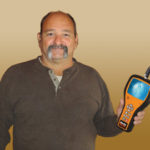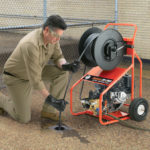One of the more popular mechanical questions routinely served up to General’s customer service department has to do with our power cable feed devices. Because the ability to answer power feed questions are essential to understanding how drum-style machines function, it’s one of the first subjects drummed into our new Drain Brains during their basic training. Because of that, it’s worth describing here.
The typical power feed conversation goes like this:
Customer: “My power feed died.”
Drain Brain: “I’m very sorry for your loss sir, was it a long illness?”
Customer: “Nope, quite sudden. It worked like a dream right up until the stroke of midnight.”
Drain Brain: “Midnight?”
Customer: “It’s a long story.”
Drain Brain: “It always is. Are you at a jobsite right now?”
Customer: “Of course! And I can’t get the snake to feed in or out.”
Drain Brain: “All right. Let’s try something. Can you remove the power feed from the unit and see if you can pull the cable out or push it in by hand?”
Customer: “By hand?”
Drain Brain: “Yes sir. You see, symptoms like yours are often the result of the cable being stuck or kinked inside the drum, and have nothing to do with the power feed. So, if you can’t pull the snake out by hand, then for sure the power feed isn’t going to be able to do it either. It’s not as strong as you are! On the other hand, if it pulls out and pushes in easily, the problem is definitely in your power feed.”
Customer (After some delay): “You’re right! I can’t budge it. It feels as though it’s tied in a knot inside there. How in the blue blazes do I get it out of there?”
Drain Brain: “Perceptive question sir. The honest answer is ‘with great difficulty.’ If you can’t coax it out through the normal route, remove the inner drum and distributor tube, which enlarges the opening in the middle of the drum. Attempt to pull it out through there. If that still doesn’t work, attack it with bolt cutters, reciprocating saw or anything else you can fit in there to cut the cable up and remove it in sections. The good news is that afterwards, when you replace it with a new cable, everything will work perfectly.”
Customer: “That sounds good! So, how do you recommend changing the cable on one of these machines?”
Drain Brain: “It’s easy! Our machines have a drum connecting cable that’s permanently attached to the inside of the drum. It’s just long enough for you to pull it out past the power feed to make connecting your new cable a snap.”
Customer: “Does it matter which direction the cable is coiled when I push it back inside the drum?”
Drain Brain: “Absolutely! Because of the way the machine and cable are engineered, installing the cable backwards can cause problems. The easiest way to describe the reloading process is that the distributor tube should move counter clockwise as you push the cable in – when viewed from in front of the machine. The distributor tube is the metal or spring tube that guides the cable between the back of the power feed to the inside of the drum. When you’re done, there’s an easy way to check to make sure the cable is in correctly. First, turn the drum so that the distributor tube is pointing straight down towards the ground. Six o’clock when standing in front of the unit! From there, you should be able to see the cable exiting the rear of the distributor tube towards the left, or clockwise. If you see that, you know that the cable is installed correctly and you’re ready for action!”
At that point, the conversation usually ends with a summary of action steps. The contractor knows that he has some work ahead of him, but has a clear idea how to solve his problem.
Next time, we’ll look at what happens when the clues point toward the power feed.
Contact the Drain Brains® at General at 800-245-6200 or by email [email protected].



